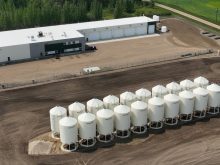A long-awaited study on removing barriers in Alberta’s beef industry is recommending a mandatory Canadian comprehensive boxed beef price report, along with measures to boost processing capacity.
Better price reporting would give producers such as feeders more information to better market their cattle, said Brad Dubeau, general manager of Alberta Beef Producers.
“We would definitely encourage us moving back to some sort of reporting and it just helps to provide more transparency.”
The Alberta Beef Competitiveness Study was released March 14 after being launched about a year and a half ago. Its recommendations include harmonizing provincially regulated processors in Alberta with federal standards, which would help producers and processors by allowing interprovincial trade in beef.
Read Also

Using artificial intelligence in agriculture starts with the right data
Good data is critical as the agriculture sector increasingly adopts new AI technology to drive efficiency, sustainability and trust across all levels of the value chain.
The study’s completion was announced by ABP, the Alberta Cattle Feeders’ Association and the Canadian Cattle Association.
Alberta Agriculture and Irrigation Minister Nate Horner said in a March 16 email that his office plans to meet with stakeholders in April to work on the next steps. “We have seen the recommendations and are committed to working together to find ways to further support the sector’s growth, find efficiencies and create jobs.”
Dubeau said the study marks the start of a lengthy period of consultation that includes processors.
“I believe that this is our first step in many different areas, so I don’t believe that nothing happens from this report,” he said.
“It might not be implemented right away, but elements of this report will continue on because we’re all of the belief that if we’re going to do reports like this, we need to try and have outcomes that actually make a difference.”
Part B of the study examined the feasibility of wholesale beef price reporting. It was prepared for ABP by Ted Schroeder, an agricultural economics professor at Kansas State University, and Lee Schulz, associate professor of economics at Iowa State University.
They recommended the creation of a mandatory Canadian comprehensive box beef report. It would be akin to the National Comprehensive Boxed Beef Cutout-All Fed Steer/Heifer Sales report in the United States, said the study.
It also recommended adding beef and dairy product sales.
“Another adjustment we suggest is adding beef sales destined for the United States or Mexico, beyond the few items (i.e. trim, etc.) that are already included, to the Canadian Boxed Beef Report.”
As a non-profit organization, Canfax conducted voluntary Canadian boxed beef reporting with the support of packers following the BSE crisis of 2003. The service was discontinued in 2020 because of concerns by processors about confidentiality combined with disruptions caused by the COVID-19 pandemic.
The study described the reporting on Canadian wholesale beef market information as thin, with the frequency worsening over time. Potential remedies include packers and government “sharing the cost of participating in the program and assurance contracts to persuade reporting,” it said.
“A mandatory reporting system should be considered as a potential component of a larger framework of strategies to reinstate and improve the Canadian wholesale beef market information reporting system.”
Part A of the study, which was prepared by Serecon Inc., looked at building resiliency and capacity in beef processing by addressing immediate labour constraints, standardizing processing standards and increasing support for processors.
Two large federally inspected packers in southern Alberta handle about 80 percent of the slaughter of Canada’s beef cattle. Meanwhile, the number of provincially regulated packers has gone through a long-term decline, affecting producers.
The study was partly based on an online survey involving 14 provincial processors, along with consultations with more than 60 stakeholders ranging from packers and producers to research institutions. It identified five barriers to establishing or expanding beef-processing capacity, with labour being the top issue.
It said problems include red tape in the federal Temporary Foreign Worker Program, an uncertain pathway to permanent residency and an emphasis on education over experience for immigration. It recommended several solutions, including setting aside 500 foreign worker positions for federally regulated packers under the Alberta Advantage Immigration program.
The study also partly linked the struggle to keep workers at small- and medium-sized provincial processors to aging facilities and an inability to access capital.
It suggested improving working conditions through measures aimed at boosting financing to upgrade equipment.
The study said market access also needs to be improved for provincially regulated processors, which are only allowed to provide beef within Alberta.
“Given the prioritization of this issue by federal, provincial and territorial (FPT) ministers of agriculture, there appears to be an opportunity at this time to push for interprovincial trade to the benefit of small and medium sized provincially regulated processors.”
The key is to harmonize provincial with federal standards, it said. Steps toward this goal could include the Alberta government seeking financial support from Ottawa to help provincial processors upgrade to Canadian Food Inspection Agency standards, it added.
Although interprovincial trade has long been desired by Alberta’s beef industry, “there’s a lot of conversation that needs to be had there,” said Dubeau.
There are reasons why there are separate federal and provincial processors, he said.
“Is there a way that is acceptable to everybody that allows for that interprovincial trade?”
















